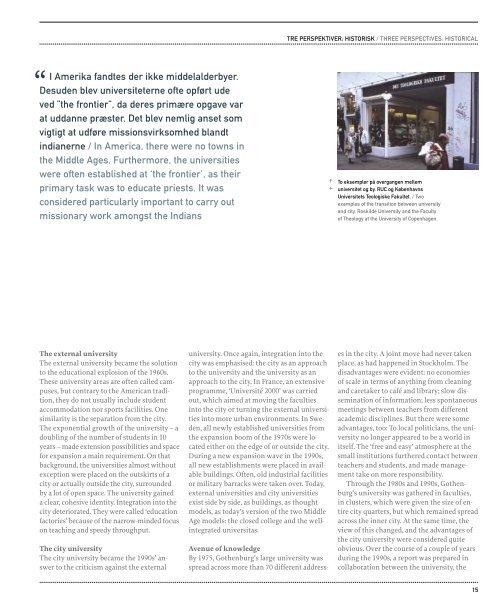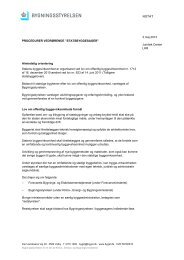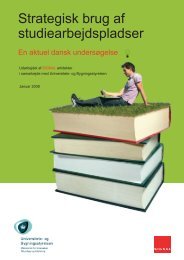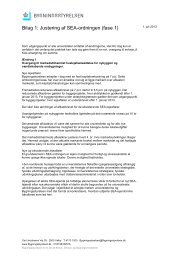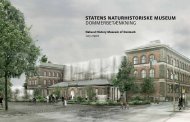Campus og studiemiljø - Bygningsstyrelsen
Campus og studiemiljø - Bygningsstyrelsen
Campus og studiemiljø - Bygningsstyrelsen
You also want an ePaper? Increase the reach of your titles
YUMPU automatically turns print PDFs into web optimized ePapers that Google loves.
“<br />
i amerika fandtes der ikke middelalderbyer.<br />
desuden blev universiteterne ofte opført ude<br />
ved ”the frontier”, da deres primære opgave var<br />
at uddanne præster. det blev nemlig anset som<br />
vigtigt at udføre missionsvirksomhed blandt<br />
indianerne / in america, there were no towns in<br />
the middle ages. Furthermore, the universities<br />
were often established at ‘the frontier’, as their<br />
primary task was to educate priests. it was<br />
considered particularly important to carry out<br />
missionary work amongst the indians<br />
the external university<br />
The external university became the solution<br />
to the educational explosion of the 1960s.<br />
These university areas are often called campuses,<br />
but contrary to the American tradition,<br />
they do not usually include student<br />
accommodation nor sports facilities. One<br />
similarity is the separation from the city.<br />
The exponential growth of the university – a<br />
doubling of the number of students in 10<br />
years – made extension possibilities and space<br />
for expansion a main requirement. On that<br />
background, the universities almost without<br />
exception were placed on the outskirts of a<br />
city or actually outside the city, surrounded<br />
by a lot of open space. The university gained<br />
a clear, cohesive identity. Integration into the<br />
city deteriorated. They were called ‘education<br />
factories’ because of the narrow-minded focus<br />
on teaching and speedy throughput.<br />
the city university<br />
The city university became the 1990s’ answer<br />
to the criticism against the external<br />
university. Once again, integration into the<br />
city was emphasised: the city as an approach<br />
to the university and the university as an<br />
approach to the city. In France, an extensive<br />
pr<strong>og</strong>ramme, ‘Université 2000’ was carried<br />
out, which aimed at moving the faculties<br />
into the city or turning the external universities<br />
into more urban environments. In Sweden,<br />
all newly established universities from<br />
the expansion boom of the 1970s were located<br />
either on the edge of or outside the city.<br />
During a new expansion wave in the 1990s,<br />
all new establishments were placed in available<br />
buildings. Often, old industrial facilities<br />
or military barracks were taken over. Today,<br />
external universities and city universities<br />
exist side by side, as buildings, as thought<br />
models, as today’s version of the two Middle<br />
Age models: the closed college and the wellintegrated<br />
universitas.<br />
avenue of knowledge<br />
By 1975, Gothenburg’s large university was<br />
spread across more than 70 different address-<br />
tre perspektiver: Historisk / tHree perspeCtives: HistoriCal<br />
i<br />
f<br />
to eksempler på overgangen mellem<br />
universitet <strong>og</strong> by. ruC <strong>og</strong> københavns<br />
universitets teol<strong>og</strong>iske Fakultet. / two<br />
examples of the transition between university<br />
and city. roskilde university and the Faculty<br />
of theol<strong>og</strong>y at the university of Copenhagen.<br />
es in the city. A joint move had never taken<br />
place, as had happened in Stockholm. The<br />
disadvantages were evident: no economies<br />
of scale in terms of anything from cleaning<br />
and caretaker to café and library; slow dissemination<br />
of information; less spontaneous<br />
meetings between teachers from different<br />
academic disciplines. But there were some<br />
advantages, too: To local politicians, the university<br />
no longer appeared to be a world in<br />
itself. The ‘free and easy’ atmosphere at the<br />
small institutions furthered contact between<br />
teachers and students, and made management<br />
take on more responsibility.<br />
Through the 1980s and 1990s, Gothenburg’s<br />
university was gathered in faculties,<br />
in clusters, which were given the size of entire<br />
city quarters, but which remained spread<br />
across the inner city. At the same time, the<br />
view of this changed, and the advantages of<br />
the city university were considered quite<br />
obvious. Over the course of a couple of years<br />
during the 1990s, a report was prepared in<br />
collaboration between the university, the<br />
15


